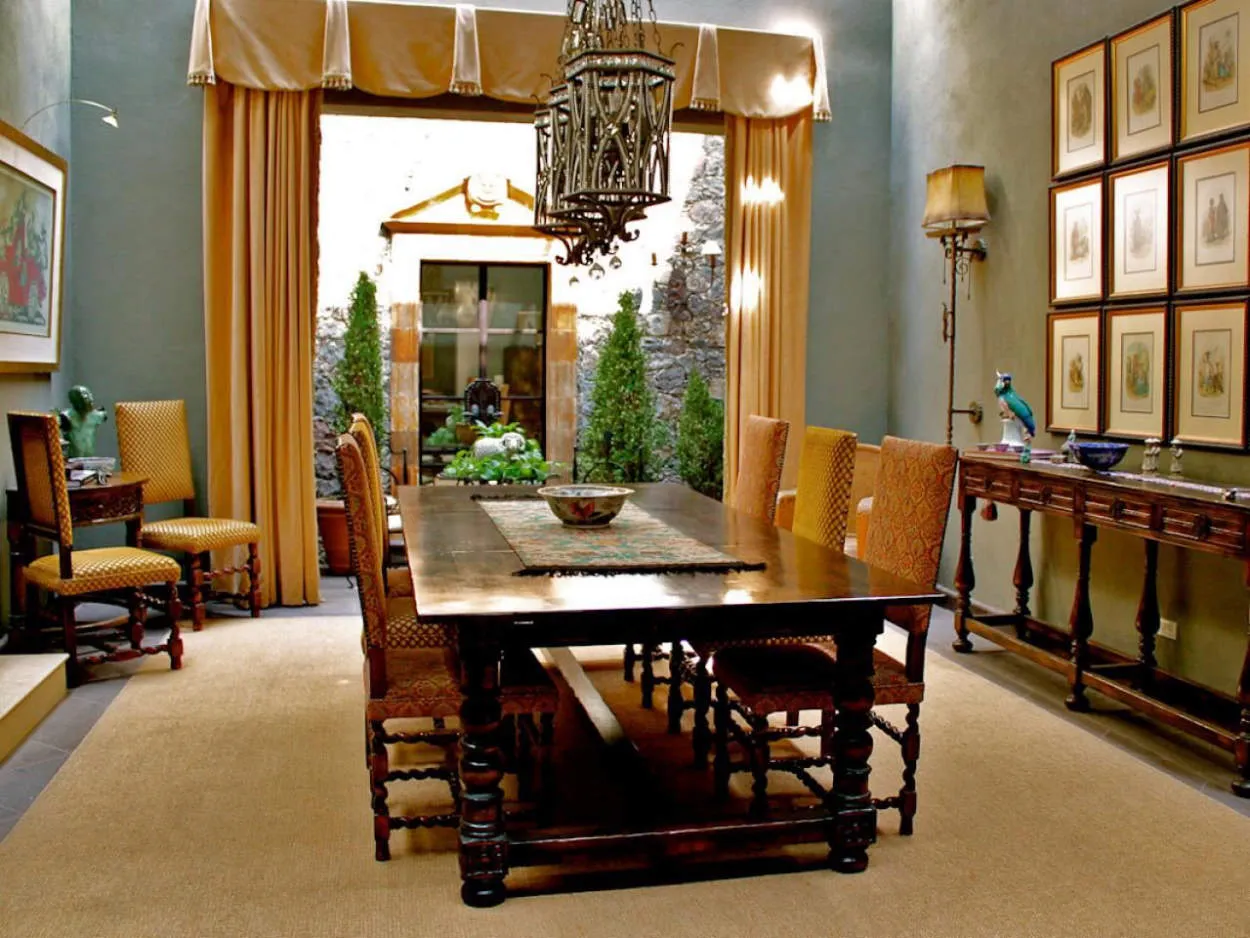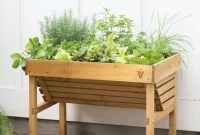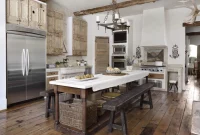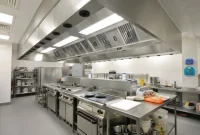Spanish style dining rooms exude a captivating blend of warmth and vibrancy. From the rich colors and textures to the intricate detailing, these spaces inspire a sense of comfort and elegance. Whether adorned with traditional tapestries or rustic wooden furniture, these dining rooms create an inviting atmosphere for family gatherings and memorable mealtime experiences.
Characteristics of Spanish Design
Spanish design is known for its distinctive characteristics that bring warmth and vibrancy to any space. Whether it’s in architecture, interior design, or furniture, Spanish style is unmistakable and full of charm.
Bold Colors and Patterns
One of the defining features of Spanish design is the use of bold colors and patterns. From vibrant reds and oranges to deep blues and earthy tones, Spanish interiors are filled with rich hues that create a warm and inviting atmosphere. Intricate tile work, ornate textiles, and intricate motifs are also commonly seen in Spanish design.
Traditional and Rustic Elements
Spanish style often incorporates traditional and rustic elements, giving spaces a timeless appeal. Exposed wooden beams, terracotta floors, and rough plastered walls are common architectural features in Spanish design. Furniture made from dark woods, such as walnut or mahogany, also adds a touch of elegance to Spanish interiors.
Handcrafted Details
Another characteristic of Spanish design is the emphasis on handcrafted details. From hand-painted tiles to intricately carved furniture, Spanish artisans take pride in their craftsmanship. These unique and carefully crafted pieces add a sense of authenticity and personality to Spanish style dining rooms.
Indoor-Outdoor Integration
Spanish design seamlessly blends indoor and outdoor spaces, creating a harmonious connection with nature. Courtyards and patios are common features in Spanish homes, allowing for alfresco dining and gatherings. Large windows and French doors are used to maximize natural light and create a seamless transition between the interior and exterior.
Eclectic and Eclectic Mix of Styles
Spanish style dining rooms often feature an eclectic mix of styles. Traditional Spanish elements, such as wrought iron details and antique furniture, are combined with modern touches to create a unique and personalized space. The result is a visually stimulating and inviting atmosphere for dining and entertaining.
Rich and Earthy Color Palette
Spanish style dining rooms are known for their warmth and vibrancy, and one key element that contributes to this ambiance is the rich and earthy color palette. Inspired by the natural beauty of the Mediterranean landscape, these dining rooms often feature warm tones of terracotta, deep browns, rusty oranges, and olive greens.
The use of these colors creates a cozy and inviting atmosphere, evoking a sense of tradition and heritage. The earthy tones also complement the rustic elements commonly found in Spanish style dining rooms, such as wooden furniture, wrought iron accents, and traditional tile work.
In addition to the warm color palette, Spanish style dining rooms often incorporate vibrant hues to add pops of energy and personality. Bright blues, vibrant yellows, and fiery reds can be found in decorative elements like ceramics, textiles, and artwork.
When designing a Spanish style dining room, it is essential to strike a balance between the rich and earthy tones and the vibrant accents. A well-executed color palette can create a harmonious and visually striking space, where warmth and vibrancy combine to create a truly inviting dining experience.
Rustic Furniture Choices
When it comes to creating a warm and vibrant Spanish style dining room, rustic furniture choices play a significant role. Rustic furniture pieces add a touch of authenticity and charm to any space, transforming it into a cozy and inviting atmosphere.
One popular choice for a Spanish style dining room is a sturdy wooden dining table. Opt for a table made from reclaimed wood or one with a distressed finish to achieve that rustic look. Pair it with matching wooden chairs featuring carved details for an added touch of elegance.
To further enhance the warmth and vibrancy, incorporate colorful accents such as vibrant textiles. Consider using traditional Spanish textiles like handwoven rugs, embroidered table runners, or vibrant cushion covers. These colorful additions can instantly brighten up the space and add a lively touch to your dining room.
Another essential furniture piece is a rustic sideboard or buffet. This functional piece not only provides ample storage for your dining essentials but also serves as a stunning focal point in the room. Look for a sideboard with intricately carved details and iron hardware to enhance the Spanish aesthetic.
Lighting is crucial in setting the right ambiance for a Spanish style dining room. Opt for wrought iron chandeliers or pendant lights with intricate designs to add a touch of elegance. The warm glow of these lights combined with the rustic furniture will create a cozy and inviting atmosphere for your dining space.
In conclusion, when designing a Spanish style dining room, incorporating rustic furniture choices is key. With the right selection of wooden tables, chairs, sideboards, and the perfect lighting, you can effortlessly achieve the desired warmth and vibrancy that defines this style.
Decorative Tile and Ironwork
In Spanish style dining rooms, decorative tile and ironwork play a crucial role in creating an atmosphere of warmth and vibrancy. These elements bring unique charm and a touch of the Mediterranean to the space, making it a standout feature of any home.
Tile
Spanish decorative tiles, known as “azulejos,” are a key element in Spanish interior design. They come in various colors, patterns, and sizes, allowing homeowners to create stunning focal points on walls, floors, or as accents on tabletops. From intricate mosaic designs to bold geometric patterns, these tiles offer endless possibilities for adding visual interest and texture to a dining room.
Ironwork
Ironwork, another signature feature of Spanish style, complements the tile beautifully. Wrought-iron chandeliers, sconces, and candleholders lend a romantic and rustic feel to the dining room. The intricate details of the ironwork create fascinating shadows when combined with warm lighting, further enhancing the cozy, inviting ambiance.
Combining Tile and Ironwork
When designing a Spanish style dining room, consider combining decorative tile and ironwork to achieve a cohesive and captivating look. For example, a wrought-iron chandelier suspended above a table with a mosaic tile top creates a stunning centerpiece. Using ironwork accents, such as chairs with iron frames or an iron wine rack, can further enhance the overall aesthetic.
Color Palette
The color palette in Spanish style dining rooms tends to feature warm earth tones, such as terracotta, beige, and deep reds. These colors not only complement the tile and ironwork but also add to the cozy and inviting ambiance. Consider incorporating the colors of the Mediterranean landscape, such as olive greens and vibrant blues, to evoke a sense of vibrant energy.
Accessories and Finishing Touches
To complete the Spanish style dining room, carefully select accessories and finishing touches. Consider adding rustic wooden furniture, colorful pottery, and embroidered textiles to enhance the overall theme. Layering textures with plush rugs, soft cushions, and textured curtains can also contribute to the warmth and vibrancy of the space.
Creating an Inviting Ambiance
In the realm of interior design, creating an inviting ambiance is essential to setting the tone and atmosphere of a space. When it comes to Spanish style dining rooms, warmth and vibrancy are key elements that can transform a simple meal into a memorable gathering.
From the furniture to the color palette, every detail plays a vital role in capturing the essence of a Spanish style dining room. Rich, earthy tones like terracotta, warm reds, and deep yellows are often used to evoke a sense of warmth and rustic charm. These hues can be incorporated through wall paint, furniture upholstery, or decorative elements such as curtains and rugs.
Another characteristic of Spanish style dining rooms is the use of natural materials. Exposed wooden beams on the ceiling, rustic tile flooring, and distressed furniture are commonly found in these spaces. These elements not only enhance the overall aesthetic but also contribute to the inviting atmosphere by creating a sense of authenticity and connection to nature.
To further enhance the warmth and vibrancy, lighting plays a crucial role. Spanish style dining rooms often feature wrought-iron chandeliers or pendant lights with intricate designs. These fixtures not only provide functional lighting but also serve as decorative focal points, adding a touch of elegance and charm to the space.
Lastly, incorporating traditional Spanish elements such as vibrant ceramic tiles, hand-painted pottery, and intricate patterns can elevate the ambiance of the dining room. These elements can be integrated through backsplashes, accent walls, or decorative accessories, infusing the space with an authentic touch of Spanish culture.
Conclusion
In conclusion, Spanish style dining rooms exude warmth and vibrancy with their rich colors, intricate details, and rustic charm. From the traditional tiled floors, elegant chandeliers, to the bold patterns and wooden furniture, these dining rooms create an inviting ambiance that is perfect for gatherings and creating lasting memories with loved ones.




